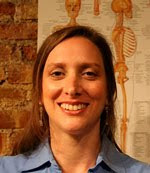Pain cut through the morning silence. My back ached and my left leg was lit up like a live wire. Breathing was difficult: moving, impossible. I knew immediately that I had inherited the family curse—I had herniated a disc in my lumbar spine.
It took three days before I could get off the floor and into the doctor’s office. Though my mobility had mostly returned, the pain was constant and numbness in my left foot made my gait unsteady. I was familiar with these symptoms because my mother had three discs removed from her spine in the eighties. I had watched her downward spiral for the two years prior to the surgeries and her slow post-operative recovery. This was not a future I looked forward to.
The doctor sent me for an MRI, which returned questionable results. A minor protrusion seemed present at L5/S1, but it was unclear whether the disc was pressing on the left nerve root. The doctor suggested a cortisone shot and a check up in six months. No one was mentioning surgery, but the specter of my mother’s experiences loomed large. I was only 20 and not ready for the kind of consequences she faced: arthritis, further surgeries, immobility and chronic pain.
I scheduled the shot and prayed. I hurt so much that I couldn’t carry my textbooks to and from class. Sitting was agonizing. During lectures, I would either stand in the back of the classroom or lay on the floor when I became too exhausted. I couldn’t move much, save for the hour a day I would spend swimming laps in the college pool. I was told not to do this—the side-to-side motion of the crawl would cause further injury—but I couldn’t bear the stasis. I was simultaneously fit and disabled—a very strange place to be.
Sadly, the cortisone shot offered no relief. I went back to the doctor after six months and surveyed my options. He told me I was a likely candidate for surgery. I asked if I could try physical therapy and he reluctantly gave me a prescription. The sessions consisted of electro-stimulation, followed by traction, and a few take-home exercises. Afterward, I would feel briefly elongated and then descend into ever-more intense pain. I went religiously three times a week for three months before giving up. My chart read: “Patient enthusiastic. Progress, minimal.”
At the nine-month mark, I haunted the library stacks in search of information. Statistics abounded regarding the poor success rate of back surgery. Patients who had had surgery fared much the same as patients who waited a year with no treatment. At my age, the wait-and-see approach was the obvious choice, but I was having a hard time holding it together. Without the aid and support from friends, I don’t think I could have survived.
During my investigation, I came across Joseph Pilates’ original mat series. Pilates was very much a part of the modern dance community, but was not widely known in other circles. After my first attempt at the exercises, I suffered a serious setback. Even though I had always been an active person, I wasn’t very core-connected. I didn’t understand how to use the triumvirate of musculature—the deep abdominal muscles, pelvic floor, and paraspinal muscles—required to stabilize my spine. My low back took over and I strained it as soon as I attempt to perform the hundreds.
I was lucky that I had friends in the dance community who directed me to an instructor with expertise and compassion. I first studied with a dancer and teacher who had extensive experience in Pilates and Body-Mind Centering. Her approach was rehabilitative and focused on helping me stabilize my spine. Cathie Caraker was a caring instructor who encouraged me to keep moving and exploring my relationship to my body. She offered far more than Pilates—she offered movement education, which helped forge a connection with my body that would serve me through many physical passions. Within three months, I was pain free.
It was years later that I decided to become a Pilates and Yoga instructor. The “cure” that I found as a young person morphed into a deep-rooted curiosity about the process of physical transformation. During my back pain episode, friends and family were crucial support systems, but the healing journey was ultimately my own. Pain, in the broadest sense, was an indicator that something needed to shift in my body, mind, and spirit to make way for a deeper understanding and appreciation of life. I had to face my fears and take on new ways of treating my body so that it could repair itself and stay well.
With back-pain clients, I am acutely aware of the distress that comes from living life in constant suffering. I see my role in the process as part inspiration, part expert, and part witness. My work focuses on identifying clients’ pain patterns, strengthening the core and deep spinal stabilizers, and improving whole-body functional movement. My mantra is awareness—when we perceive what is going on in the body, we can relax into our strength. We not only get longer, leaner, and more supple, we begin to move with intelligence. I have seen many clients shift from disability to athletic ability in a few short months.
I encourage anyone in this situation to reach out for help. Pilates and yoga have kept me active and free for many years. They can do the same for you.

